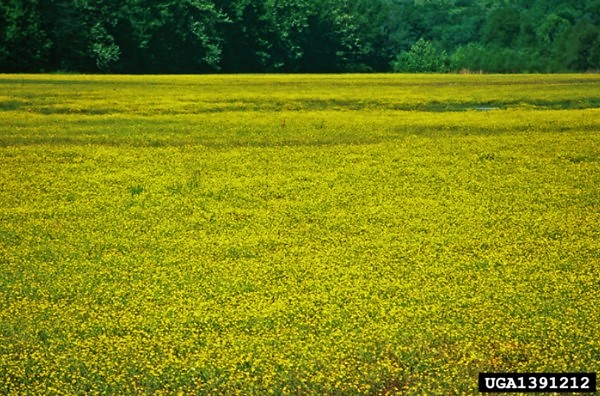
Field full of flowering buttercup, a problem weed that is toxic to all livestock. John D. Byrd, Mississippi State University, Bugwood.org
What’s up, buttercup? While these plants are not in full bloom just yet, buttercup-infested pastures will turn into a sea of yellow come springtime. Though a sea of yellow flowers sprawling across an open pasture may be a beautiful sight to onlookers, this plant can be a real management headache for pasture and hay fields. Why? To name a few reasons, buttercup is toxic to livestock, spreads aggressively, and is difficult to control.
Buttercup is toxic to all species of livestock. The toxin (protanemonin) is released when the plant is chewed or otherwise wounded and is present in all parts of the plant. Animals that eat buttercup may suffer from blistering of the mouth and internal parts of the gastrointestinal tract, diarrhea, colic, and, in severe cases, death. Fortunately, most animals will not eat buttercup because it is unpalatable. The toxin becomes inactivated when dried, so buttercup is not a concern in hay.
Knowing how to identify this problem plant, understanding its life cycle, and selecting a combination of management tactics to control its spread all play a part in successfully dealing with a buttercup infestation. Some of the best ways to combat weed issues are to select well-adapted grass and/or legume species that will grow and establish rapidly. This will minimize the length of time for weeds to invade easily. A healthy stand of forage is a resilient stand. Lime and fertilize according to soil test recommendations. Maintaining a proper pH and nutrient status is essential in ensuring the forage will grow rapidly and be more competitive with weeds.
As I mentioned, buttercup is a cool season weed that begins to flower in the springtime, but it’s during the winter months that the vegetative growth of buttercup takes place. Generally, many fields that have dense buttercup populations are fields heavily grazed by animals during the fall through the early spring months. Therefore, another critical management strategy is to manage grazing properly. If you have a dense population of buttercups in your pasture, then mowing fields or clipping plants close to the ground in the early spring before buttercup plants can produce flowers can help reduce the amount of new seed produced, but mowing alone will not totally eliminate these plants and their seed production.
If your infestation is bad enough, then you may need to seek a chemical control option but don’t wait until these plants are in full bloom. By the time these plants are in full bloom, they’re at their toughest stage and you’ve missed your best opportunity window to halt seed production. Additionally, spraying these plants while they’re in full bloom can harm our valuable beneficial pollinating insects.
Herbicides registered for use on grass pastures that contain 2,4-D will effectively control buttercup, but depending on any additional weeds present, a pasture manager may also select other products. However, and this is a big however, any desirable legumes present, such as clovers interseeded along with the grass can be severely injured or killed by these herbicide products.
For optimum results, apply a herbicide in the early spring (February – April) before flowers are observed. Again, the goal is to hit these plants when they are still small and actively growing in a vegetative state. For best herbicide activity, wait until daytime air temperatures are greater than 50 F for two to three consecutive days. When determining which product is best for your operation, be sure to read product labels to find out the details about grazing and haying restrictions as they vary widely between these products. Need help selecting a product? Contact the County Extension office for assistance.